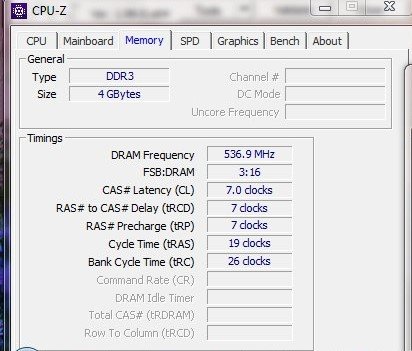Memory Frequency score 536.9 MHz with a DDR3 1066MHz SODIMM
Thursday, 01 January 1970 07:00 | Update at null
Media Gallery
Screenshot

Device, Setup, etc


URL
-https://bit.ly/3AoVNie
Information Detail
Hardware: DDR3 1066MHz SODIMM
Specs:RAM Total Capacity : 2GB + 2GB
Brand : ADATA & Micron
Frequency : 1600MHz (limit form processors to 1066MHz)
Configure : 2 DIMM 1066MHz
Form Factor : SODIMM
Timing : 7-7-7-19
Software: Memory Frequency
Score: 536.9 MHz
About: Memory FrequencyMemory Frequency is a test to measure the clock speed of RAM or system memory. Memory frequency (usually in MHz) refers to how fast the memory can transfer data to the CPU and other components. This test provides insight into how many data transfers per second the system memory can perform at a given frequency, which has an effect on overall system performance especially in applications that rely heavily on memory speed.
Setting the memory to a higher frequency can provide improved performance in applications that require a lot of data to be processed in a short period of time, such as programming applications, video processing, or graphics-intensive games. However, keep in mind that increasing the frequency also depends on the capacity and capabilities of the motherboard and memory chips.
DDR3 1066MHz SODIMM is a type of low-medium speed RAM that is still widely used in older generation laptops or devices with limited specifications. With the SODIMM (Small Outline Dual In-line Memory Module) form factor, this module is specifically designed for compact devices such as notebooks and mini PCs. The configuration in this test uses two pieces of RAM from different brands, ADATA and Micron, each with a capacity of 2GB, bringing the total memory to 4GB in single-channel mode.
Although the RAM modules have a native frequency of 1600MHz, the system sets the speed limit to 1066MHz due to the limitations of the AMD E1-1200 processor used in the HP 1000 1b05AU laptop. This is a clear example of how RAM speed also depends on CPU and motherboard architecture support. The memory timings were recorded at 7-7-7-19, which indicates a fairly tight latency configuration for the entry-level DDR3 class, providing a balance between stability and efficiency.
Tests were conducted in Windows 7 and Windows 8 operating systems, which are quite common on devices with these specifications. Based on synthetic performance testing using PYPrime 2B (via BenchMate), the completion time was recorded at 2 minutes 3 seconds 3 milliseconds, reflecting the system's capability in handling light to medium computing workloads. Meanwhile, a benchmark using AIDA64 showed a Memory Read score of 5529 points, which is quite good for this class of frequency-limited DDR3 RAM.
Overall, this combination of DDR3 1066MHz SODIMMs with a total capacity of 4GB is still reliable for running light operating systems, browsing, and other basic computing tasks on older generation laptops. While it can't match the performance of a modern DDR4 or DDR5, this RAM is still relevant for users who want to revive an older laptop for light use or simply as a backup device. With its affordable price and wide availability in the market, DDR3 SODIMM is a great choice for a cost-effective and functional upgrade.
Device test (testbed)
Device: HP 1000 1b05au
CPU: AMD E1-1200
RAM: 2x2GB Single Channel (limit from CPU)
OS: Windows 7, Windows 8
* Not Avaiable
